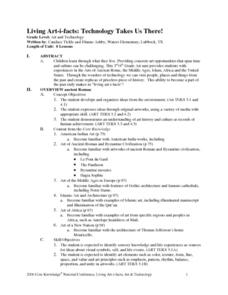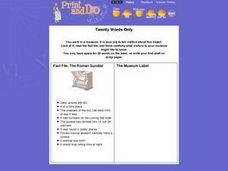University of California
Bread and Circuses: Rome as a Site of Encounter
An intriguing lesson uses 12 Roman artifacts to explain Roman society and politics. Young historians view images of artifacts and learn how each one represents an aspect of Roman society. Academics also complete a hands-on activity to...
Curated OER
Living Art-i-facts: Technology Takes Us There!
Students create living artifacts dealing with different times and cultures. They explore Ancient Rome, the Middle Ages, Islam, Africa, and the United States.
University of California
Religious Influences
While the Roman empire often conjures up images of soldiers and emperors, its culture was more complex. Using primary sources, including ancient historians and pictures of artifacts, pupils consider the religious influences on Roman...
Curated OER
Lost Roman Treasure
Students simulate what it would be like to be archeologists. They evaluate a quadrant area of a lost Roman treasure map. They generate their findings on the map into specific categorizes.
Curated OER
social Studies: Yesterday, Today, and Tomorow
Sixth graders take an Internet trip back in time to explore ancient cultures. Working in teams, they assume the roles of theologian, cartographer, economist, political analyst, and anthropologist. The same groups then create time...
Curated OER
No Title
Students explore and analyze various Roman artifacts to assess how they survived over time, their organic materials, categories and images. They evaluate Roman, silver, and bronze coinage for their emperor's titles and depict mythical...
Curated OER
Twenty Words Only
In this museum label worksheet, students examine a picture of a Roman sundial artifact and read the information below it. Using 20 words or less, students write a museum label that would tell visitors about this object.
Curated OER
Roman Military
Learners research the Internet to define the Roman Military and differentiate between its three major units. They write a 2 page report describing and defining each unit of the Roman Military and comparing and contrasting these units...
Curated OER
What Culture Game?
Students examine artifacts from ancient cultures. They compare the differences and some similarities that may exist . They decide on at least two artifacts per area for each of the three cultures chosen and explore diversity.
American Museum of Natural History
Mint Your Own Coin
Provide young archaeologists with an opportunity to craft their own artifacts. The step-by-step directions in an engaging resource show them how to mint their own coin, complete with image, date, and motto.
Curated OER
Inca Artifacts and Civilization Lesson Plans
By learning about Inca artifacts and this ancient civilization students can delve into history, geography, and much more.
Curated OER
Underwater Excavation
Students calculate artifact size and ship capacity based on the excavation of an ancient Roman shipwreck.
Curated OER
Digging Into the Past
Students participate in an excavation simulation, and explore the ruins of Sardis. They ponder which clues scientists use to determine if artifacts found in the excavation are of Persian, Greek, Roman, Byzantine, or Lydian origin.
Curated OER
Mythology and Ancient Civilizations
Third graders examine ancient world civilizations and the mythologies they created to explain natural phenomena, as well as the writers and poets who wrote about the mythologies.
Curated OER
Ancient Mediterranean Trade Fair
Sixth graders begin the instructional activity by discussing how artifacts are located. In groups, they define the terms supply, demand, resources and trade and discuss how the United States is affected by International trade. They use...
Curated OER
Primary Sources and Archaeology in the Study of Ancient Mediterranean Trade
Tenth graders begin the lesson by plotting trade routes, major empires and items traded. Using primary sources, they examine their own values regarding trading items for royality. They participate in a role-play exercise in which they...
Penguin Books
Educator's Guide: The Da Vinci Code by Dan Brown
Dan Brown's The Da Vinci Code is filled with secrets. Help readers find the clues, solve the riddles and puzzles, and unwrap the mysteries with a six-page guide that includes before, during, and after reading discussion questions and...
Curated OER
"Hard Luck" La Salle
Fourth graders examine life of French explorer, La Salle, and how he impacted settlement of Texas and the establishment of Catholic missions in Texas; students write letters from the perspective of an explorer.
Curated OER
The Ruins of Pompeii: A Window into History
Sixth graders research the history of Pompeii and its destruction. Locate important geographical features of Rome. Gain insight into the past through archaeological interpretation. Synthesize historical information through imaginative...
Curated OER
Cargoes from Three Continents Ancient Mediterranean Trade
Sixth graders begin the lesson by researching the different types of ships and shipbuilding techniques used to help trade in the Mediterranean Sea. Using different objects, they determine what one can tell about a society and discuss...
Curated OER
Scratch, Glue, Foil & Paint
Students sculpt large Greek and Roman letter design motifs, and replicate other examples of Greek and Roman artwork.
Curated OER
Real-World Applications to Imaginary and Complex Numbers
Authenticate imaginary numbers through real-life applications in science, math, and literature.
American Museum of Natural History
Inca Investigation
A fascinating interactive resource lets young archaeologists dig through the history of Huanuco Pampa. The Inca city, located high in the Andes mountains of Peru, was once a thriving community. Craig Morris has spent years researching...
American Museum of Natural History
What Do You Know About Horses?
A 10-question online quiz tests scholars' knowledge about horses: all answers come with an informative explanation.

























